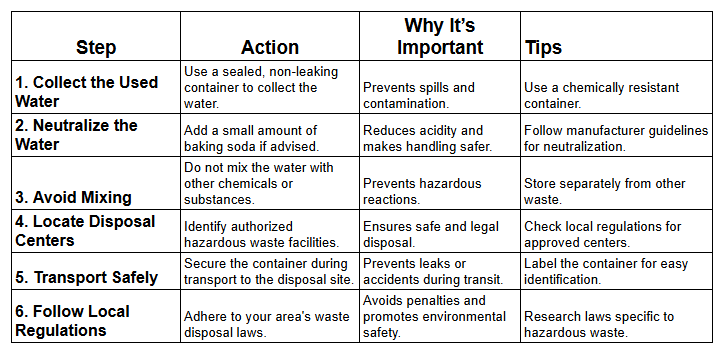How to Dispose Used Distilled Water from Your Inverter Battery
Introduction
Inverter batteries play a critical role in ensuring a continuous power supply during power outages. These batteries often require maintenance, and one of the essential aspects of this upkeep is the addition of distilled water. Distilled water is used in flooded lead-acid inverter batteries to maintain the electrolyte levels, which is vital for the battery's proper functioning.
However, once the water in the battery is used, it must be disposed of correctly. Improper disposal of used distilled water can pose significant environmental and health risks. This guide provides a step-by-step process on how to dispose of used distilled water from your inverter battery, ensuring safe practices for both you and the environment.
Key Takeaway
- Avoid Direct Disposal: Never pour used distilled water from your inverter battery directly into drains, soil, or water bodies, as it may contain harmful chemicals and contaminants.
- Use a Sealed Container: Collect the used water in a non-leaking, chemically resistant container to prevent spills and environmental contamination.
- Identify Hazardous Waste Centers: Locate authorized hazardous waste disposal facilities or recycling centers in your area to handle the waste responsibly.
Epochem Distilled Water 20 Liters
Understanding Distilled Water in Inverter Batteries
What is Distilled Water and Why is it Used in Batteries?
Distilled water is water that has been purified by distillation, a process where the water is boiled to produce steam, which is then condensed back into liquid form. This process removes impurities, minerals, and other dissolved solids that could interfere with the chemical processes inside the inverter battery.
Inverter batteries, especially lead-acid batteries, require water to maintain the proper fluid levels in the electrolyte, which is a mixture of sulfuric acid and water. As the battery operates, some of the water evaporates, and periodic topping up with distilled water is needed to keep the electrolyte level correct.
Read more....Why Use Distilled Water For Inverter Battery
Role of Distilled Water in Maintaining Battery Performance
Distilled water helps maintain the balance of the electrolyte in the battery, ensuring that it performs optimally. Without adequate distilled water, the battery’s internal components can become damaged, leading to reduced efficiency, overheating, or complete failure.
The use of distilled water is crucial because ordinary tap water contains minerals and impurities that can lead to the formation of harmful deposits or shorten the lifespan of the battery.
How Distilled Water Becomes “Used”
The term "used distilled water" refers to water that has already been added to the battery to replace evaporated water. Over time, the water in the battery may become contaminated with chemicals from the electrolyte, especially if the battery has been overfilled or exposed to extreme conditions. In such cases, the water may need to be replaced, and the old water should be disposed of safely.
Epochem Electrolyte 20L
Why You Should Dispose of Used Distilled Water Correctly
Proper disposal of used distilled water is important for several reasons:
Environmental Impact
Distilled water itself is not hazardous, but it may contain traces of sulfuric acid or other chemicals that were dissolved from the battery's electrolyte. If disposed of incorrectly, these substances can contaminate soil and water sources, harming the environment. The chemicals can also be toxic to plants and animals, leading to long-term ecological damage.
Health Risks
Handling used distilled water without proper care can expose you to harmful chemicals, especially sulfuric acid. Direct contact can cause skin burns or irritation, and inhalation of vapors from battery acid can be dangerous. Proper disposal practices minimize health risks for you and anyone around the area.
Read more....How Distilled Water Powers Up Your Inverter Battery
Legal and Regulatory Considerations
Many regions have strict regulations governing the disposal of waste materials like used battery water. These laws are designed to protect both the environment and public health. Disposing of used distilled water incorrectly can result in fines or legal repercussions, so it’s important to familiarize yourself with local disposal regulations and comply with them.
Steps for Safely Disposing of Used Distilled Water
Step 1: Identify the Waste
Before disposing of used distilled water, it's important to confirm that the water you are dealing with is actually used water from the inverter battery. If the water contains contaminants or is mixed with other chemicals, it may need to be treated as hazardous waste.
If the water appears clean and is just the result of normal evaporation, it may be safe for disposal in small quantities through household drains (depending on local regulations). However, if there are signs of contamination, it’s best to handle it with caution.
Step 2: Check Local Regulations
Every locality has different rules regarding waste disposal, and used battery water may be subject to special guidelines. In many areas, used distilled water from batteries must be treated as hazardous waste due to the potential presence of sulfuric acid.
Check with your local environmental agency, waste management authority, or public health office for specific rules. Many cities offer resources or have collection centers for hazardous materials, including used battery water.
Step 3: Contact Waste Disposal Services
If your region does not allow the disposal of used battery water down the drain, you can contact a licensed waste disposal service. These professionals are equipped to handle hazardous materials safely. They will collect the water and ensure it is disposed of in accordance with environmental regulations. Many waste disposal services offer scheduled pick-ups for hazardous waste materials.
Epochem Distilled Water 200 Liters
Alternatives to Disposal
In some cases, it may be possible to reuse or repurpose the used distilled water instead of disposing of it. Here are a few alternatives:
Repurposing for Non-Consumable Uses
- Gardening: If the water is free from contaminants, it might be used to water non-edible plants. However, it’s essential to check if the pH level of the water has changed due to contact with the battery chemicals.
- Cleaning: The water can be used for cleaning non-sensitive surfaces like windows, floors, or tools.
- Industrial Use: Some industrial applications may accept used distilled water as part of their processes, especially if it's not heavily contaminated.
Read more....The Dangers of Using Tap Water in Your Inverter Battery
Before repurposing, always ensure that the water is safe for its intended use, and check for any chemical residues.
Steps for Safely Disposing Used Battery Water

Preventive Measures to Reduce Waste
One of the best ways to handle the disposal of used distilled water is to minimize the need for frequent replacement in the first place. Proper maintenance of your inverter battery can reduce the amount of distilled water you need to replace over time. Here are some tips to help you reduce waste:
Proper Battery Maintenance
Regular maintenance of your inverter battery ensures it operates at peak efficiency and minimizes the loss of distilled water. Some key maintenance practices include:
- Check water levels regularly: Frequently check the water levels in your inverter battery to ensure it doesn’t run dry. Top up with distilled water only when necessary, and avoid overfilling to prevent spillage.
- Ensure proper ventilation:Ensure the battery is kept in a well-ventilated space to minimize the evaporation of water. Inverter batteries in hot or poorly ventilated areas tend to lose water faster.
- Avoid deep discharge: Deep discharges (draining the battery too low) can lead to more evaporation. Try to maintain a moderate charge level to reduce water consumption.
- Use high-quality distilled water: Using high-quality distilled water reduces the risk of contamination and minimizes the need for frequent water replacement. Poor-quality water may introduce impurities, requiring more frequent changes.
Water Level Indicators
Some advanced inverter systems come with built-in water level indicators. These indicators can help you monitor the water levels and ensure that you only add distilled water when necessary. By avoiding overfilling or adding excess water, you can prevent wasting distilled water.
Epochem Deionized water 20 litres
Best Practices for Battery Maintenance
To ensure that you don’t need to dispose of distilled water frequently, the following best practices for battery maintenance are important:
Check Electrolyte Levels Regularly
If you have a flooded lead-acid battery, it’s essential to regularly check the electrolyte levels. Use a hydrometer to measure the specific gravity of the electrolyte, which will give you an idea of whether the electrolyte is diluted and needs replenishment. Only top up the water when the electrolyte level is low.
Ensure Correct Battery Charging
Overcharging or undercharging the battery can lead to excessive water loss or inefficient performance. Always use the correct charger for your inverter battery to avoid issues with water evaporation. Consider investing in a charger with a built-in charge controller to maintainan optimal charging rate.
Keep the Battery Clean
Dirt and debris can interfere with the battery's performance and cause it to use more water. Keep your battery clean, and regularly inspect the terminals and other components for any corrosion, which can affect its performance and efficiency.

Frequently Asked Questions
1. Can I dispose of used distilled water from my inverter battery down the drain?
It depends on the local regulations. If the water contains contaminants like sulfuric acid, it may need to be treated as hazardous waste. Always check with local authorities before disposing of it down the drain.
2. What should I do if the distilled water from my inverter battery is contaminated?
If the water appears to be contaminated, it is best to contact a hazardous waste disposal service. Do not attempt to dispose of contaminated water through regular waste channels.
3. Can I reuse the distilled water from my inverter battery?
If the water has not been contaminated with harmful chemicals, you may be able to repurpose it for cleaning or gardening purposes. However, always check for any signs of contamination before reusing it.
4. How often should I check the water levels in my inverter battery?
Water levels should be checked at least once a month, or more frequently if you notice signs of overcharging or excessive evaporation. Regular checks help you maintain the right water level without overfilling.
5. Is there a way to avoid frequently disposing of used distilled water?
Yes, by maintaining your inverter battery properly—ensuring proper ventilation, avoiding deep discharges, and using high-quality distilled water—you can minimize the frequency of water replacements and reduce the need for disposal.
Related Articles
Distilled vs. Tap Water for Inverter Batteries: What's the Difference?
Distilled Water for Solar Inverter Batteries
Inverter Battery Maintenance: The Importance of Distilled Water
Conclusion
Proper disposal of used distilled water from your inverter battery is essential for protecting the environment, maintaining public health, and adhering to local regulations. By understanding the role of distilled water in battery maintenance and following the safe disposal methods outlined in this guide, you can ensure that you dispose of used water responsibly.
For all your welding needs, whether it’s for maintenance, fabrication, or repairs, Tikweld Welding Supplies and Services is here to help! Explore our range of high-quality welding tools and services atTikweld. Whether you're working on inverter batteries or other welding projects, we've got you covered with the best products and expert services. Visit our site today!












